实验生物学_细胞基因操作
高中生物第3章基因工程第节基因工程的基本操作程序教案选择性3

第2节基因工程的基本操作程序课标内容要求核心素养对接阐明基因工程的基本操作程序主要包括目的基因的筛选与获取、基因表达载体的构建、将目的基因导入受体细胞和目的基因的检测与鉴定。
1。
科学思维:结合生产实例,举例说出基因工程的基本操作程序。
2.科学探究:针对人类生产和生活的某一需求,尝试提出初步的基因工程构想,完成初步设计。
一、目的基因的筛选与获取1.目的基因(1)概念:用于改变受体细胞性状或获得预期表达产物等的基因。
(2)实例:培养转基因抗虫棉用到的目的基因是Bt抗虫蛋白基因.2.筛选合适的目的基因(1)较为有效的方法:从相关的已知结构和功能清晰的基因中进行筛选。
(2)实例:在培育转基因抗虫棉之前,科学家不仅掌握了Bt基因的序列信息,也对Bt基因的表达产物—-Bt抗虫蛋白有了较为深入的了解。
(3)认识基因结构和功能的技术方法:DNA测序技术、遗传序列数据库、序列比对工具。
3.利用PCR获取和扩增目的基因(1)PCR的含义:PCR是聚合酶链式反应的缩写,它是一项根据DNA半保留复制的原理,在体外提供参与DNA复制的各种组分与反应条件,对目的基因的核苷酸序列进行大量复制的技术.(2)条件:DNA模板、分别与两条模板链结合的2种引物、四种脱氧核苷酸、耐高温的DNA聚合酶。
(3)过程:①变性:温度上升到90 ℃以上,目的基因DNA受热变性后解为单链.②复性:温度下降到50 ℃左右时,两种引物通过碱基互补配对与两条单链DNA结合。
③延伸:温度上升到72 ℃左右时,溶液中四种脱氧核苷酸在耐高温的DNA聚合酶的作用下加到引物的3′端合成子链.④重复循环多次。
(4)结果:每次循环后目的基因的量增加一倍,即成指数形式扩增(约为2n)。
二、基因表达载体的构建1.构建基因表达载体的目的(1)使目的基因在受体细胞中稳定存在,并且可以遗传给下一代。
(2)使目的基因能够表达和发挥作用。
2.基因表达载体的组成[填图]3.基因表达载体的构建首先用一定的限制酶切割载体,使它出现一个切口,然后用同种限制酶或能产生相同末端的限制酶切割目的基因的DNA片段,再利用DNA连接酶将目的基因片段拼接到载体的切口处。
高中生物基因重组实验教案

高中生物基因重组实验教案
实验目的:通过本实验,学生可以了解基因重组技术的原理和应用,掌握基因工程的基本操作技能。
实验材料:
1. 大肠杆菌菌种
2. 质粒DNA
3. 荧光素底物
实验步骤:
1. 将质粒DNA和大肠杆菌菌种分别取出,让其回温至室温。
2. 在洁净的实验台上,取出一个无菌平板,将大肠杆菌菌种均匀涂抹在平板上。
3. 利用移液枪或其他合适的工具,向大肠杆菌菌种中转染质粒DNA。
4. 将转染后的大肠杆菌平板进行培养,并在适当的温度下放置一段时间。
5. 观察培养后的大肠杆菌菌落,通过照射荧光素底物,观察是否有发光现象。
6. 如有发光现象,则说明成功实现了基因重组。
实验注意事项:
1. 实验中所有操作都需在洁净环境下进行,避免外部杂质的干扰。
2. 质粒DNA和大肠杆菌菌种皆需在合适的保存条件下保存,避免受到污染或损坏。
3. 实验中使用的荧光素底物需遵循生物安全规范使用,避免对环境和个人造成伤害。
拓展实验:
1. 可以尝试使用不同种类的质粒DNA和大肠杆菌菌种进行实验,观察不同基因组合的结果。
2. 可以了解基因重组技术在医学、农业等领域的应用,深入探讨基因工程的潜力及争议。
实验总结:
通过本实验,学生可以了解基因重组技术的基本原理和操作方法,培养实验操作能力和科学思维。
同时,也能够拓展对基因工程技术的认识,为未来的学习和研究奠定基础。
医学细胞生物学实验

细胞凋亡诱导与检测
细胞凋亡检测
细胞凋亡诱导
自噬诱导
通过饥饿、药物刺激等手段诱导细胞自噬,以研究自噬的生物学意义和作用机制。
自噬检测
采用荧光染色、电镜观察、蛋白质印迹等方法检测自噬体的形成、数量和相关蛋白的表达。
自噬诱导与检测
03
02
01
实验原理
实验设计
根据实验目的和原理,设计具体的实验方案和操作流程。
实验操作
按照实验方案进行实验操作,包括细胞培养、显微观察、分子生物学检测等步骤。
数据收集与分析
收集实验数据,进行统计分析,得出实验结果。
结果汇报与讨论
将实验结果以书面形式汇报,并进行讨论和总结。
实验步骤
02
细胞培养
CHAPTER
利用免疫荧光染色、荧光共振能量转移等技术,可以检测和定位细胞内特定信号分子的分布和动态变化,进而揭示其在信号转导中的作用机制。
详细描述
总结词
信号转导抑制剂的应用
总结词:信号转导抑制剂是一类能够干扰细胞信号转导过程的化合物,具有潜在的治疗作用。
07
细胞凋亡与自噬研究
CHAPTER
通过使用化学物质、射线、病毒等手段诱导细胞凋亡,以研究其发生机制和生物学意义。
电子显微镜
利用电子束代替可见光,观察细胞超微结构。
显微镜观察
通过显微镜或细胞计数板,统计细胞数量。
细胞计数
利用染色剂或荧光染料,检测细胞活性,如MTT法、染色排除法等。
细胞活力检测
细胞计数与活力检测
利用染色剂对细胞进行染色,以便观察细胞形态和结构。
染色技术
《生物学实验操作手册》
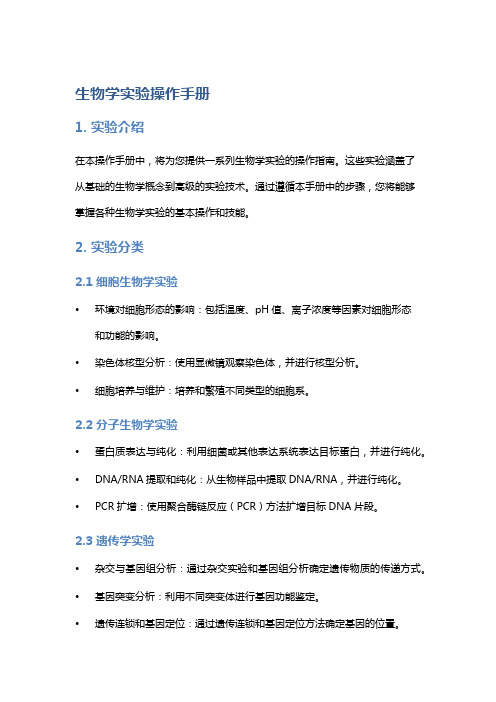
生物学实验操作手册1. 实验介绍在本操作手册中,将为您提供一系列生物学实验的操作指南。
这些实验涵盖了从基础的生物学概念到高级的实验技术。
通过遵循本手册中的步骤,您将能够掌握各种生物学实验的基本操作和技能。
2. 实验分类2.1 细胞生物学实验•环境对细胞形态的影响:包括温度、pH值、离子浓度等因素对细胞形态和功能的影响。
•染色体核型分析:使用显微镜观察染色体,并进行核型分析。
•细胞培养与维护:培养和繁殖不同类型的细胞系。
2.2 分子生物学实验•蛋白质表达与纯化:利用细菌或其他表达系统表达目标蛋白,并进行纯化。
•DNA/RNA提取和纯化:从生物样品中提取DNA/RNA,并进行纯化。
•PCR扩增:使用聚合酶链反应(PCR)方法扩增目标DNA片段。
2.3 遗传学实验•杂交与基因组分析:通过杂交实验和基因组分析确定遗传物质的传递方式。
•基因突变分析:利用不同突变体进行基因功能鉴定。
•遗传连锁和基因定位:通过遗传连锁和基因定位方法确定基因的位置。
3. 实验步骤示例3.1 细胞生物学实验中的步骤示例实验名称:观察温度对细胞形态的影响1.准备培养细胞所需的培养基及培养器具。
2.将细胞接种到已经预先消毒并加入培养基的培养皿中。
3.设立不同温度条件下的实验组,将培养皿置于恒温箱中。
4.观察细胞在不同温度条件下的形态变化,并记录相应数据。
5.结束实验后,根据数据结果进行统计和分析。
3.2 分子生物学实验中的步骤示例实验名称:DNA提取与纯化1.准备待提取DNA的生物样本,如血液或植物组织等。
2.使用特定试剂对样本进行细胞破碎和溶解。
3.添加相关酶和缓冲液,促使DNA释放并与其他细胞组分分离。
4.经过离心等步骤,收集纯化后的DNA溶液。
5.使用吸光光度计或凝胶电泳等方法检测DNA提取纯度和浓度。
3.3 遗传学实验中的步骤示例实验名称:杂交实验确定基因型1.准备不同基因型的个体进行交叉杂交。
2.收集得到的杂种后代,并对其表型进行观察和记录。
分子生物学基本实验操作
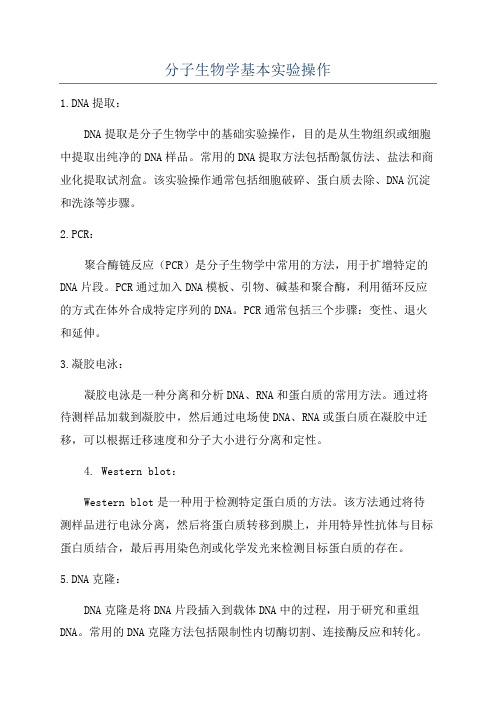
分子生物学基本实验操作1.DNA提取:DNA提取是分子生物学中的基础实验操作,目的是从生物组织或细胞中提取出纯净的DNA样品。
常用的DNA提取方法包括酚氯仿法、盐法和商业化提取试剂盒。
该实验操作通常包括细胞破碎、蛋白质去除、DNA沉淀和洗涤等步骤。
2.PCR:聚合酶链反应(PCR)是分子生物学中常用的方法,用于扩增特定的DNA片段。
PCR通过加入DNA模板、引物、碱基和聚合酶,利用循环反应的方式在体外合成特定序列的DNA。
PCR通常包括三个步骤:变性、退火和延伸。
3.凝胶电泳:凝胶电泳是一种分离和分析DNA、RNA和蛋白质的常用方法。
通过将待测样品加载到凝胶中,然后通过电场使DNA、RNA或蛋白质在凝胶中迁移,可以根据迁移速度和分子大小进行分离和定性。
4. Western blot:Western blot是一种用于检测特定蛋白质的方法。
该方法通过将待测样品进行电泳分离,然后将蛋白质转移到膜上,并用特异性抗体与目标蛋白质结合,最后再用染色剂或化学发光来检测目标蛋白质的存在。
5.DNA克隆:DNA克隆是将DNA片段插入到载体DNA中的过程,用于研究和重组DNA。
常用的DNA克隆方法包括限制性内切酶切割、连接酶反应和转化。
通过将DNA片段插入载体中并转化至宿主细胞,可以大量复制目标DNA并随后进行研究。
6.基因测序:基因测序是确定DNA或RNA序列的方法,用于分析基因组、转录组和序列变异。
常用的基因测序方法包括链终止法(Sanger测序)和下一代测序(NGS)。
通过测序,可以获取DNA或RNA的序列信息,并进一步研究基因功能和变异。
7.基因表达分析:基因表达分析通过检测RNA水平来研究基因的表达情况。
常用的方法包括实时定量PCR、Northern blot和转录组测序。
这些方法可以定性和定量地研究基因的表达水平,并帮助解析基因调控和信号通路。
这些是分子生物学的一些基本实验操作。
当然,随着技术和方法的不断发展,分子生物学领域中还有许多其他的实验操作,用于研究生物分子结构和功能。
分子生物学大实验——目的基因的克隆及表达

分子生物学大实验——目的基因的克隆及表达第一节基因操作概述............................................................................. 错误!未定义书签。
一、聚合酶链式反应(PCR) ............................................................. 错误!未定义书签。
二、质粒概述................................................................................... 错误!未定义书签。
三、凝胶电泳................................................................................... 错误!未定义书签。
四、大肠杆菌感受态细胞的制备和转化....................................... 错误!未定义书签。
五、重组质粒的连接....................................................................... 错误!未定义书签。
六、限制性内切酶消化................................................................... 错误!未定义书签。
七、SDS-PAGE蛋白质电泳........................................................... 错误!未定义书签。
第二节材料、设备及试剂..................................................................... 错误!未定义书签。
细胞生物学的实验方法与技巧
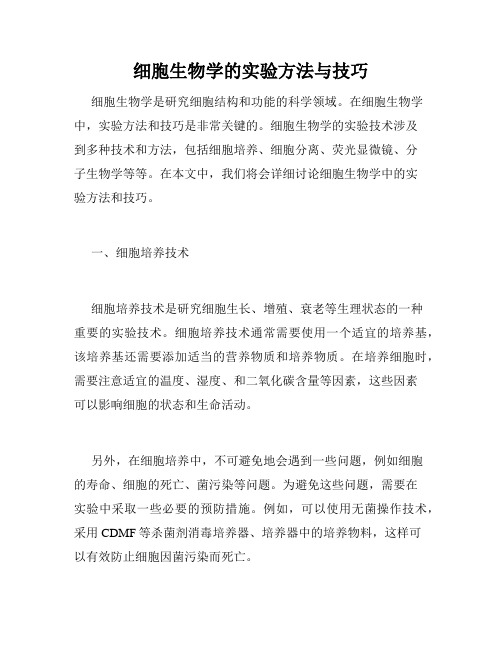
细胞生物学的实验方法与技巧细胞生物学是研究细胞结构和功能的科学领域。
在细胞生物学中,实验方法和技巧是非常关键的。
细胞生物学的实验技术涉及到多种技术和方法,包括细胞培养、细胞分离、荧光显微镜、分子生物学等等。
在本文中,我们将会详细讨论细胞生物学中的实验方法和技巧。
一、细胞培养技术细胞培养技术是研究细胞生长、增殖、衰老等生理状态的一种重要的实验技术。
细胞培养技术通常需要使用一个适宜的培养基,该培养基还需要添加适当的营养物质和培养物质。
在培养细胞时,需要注意适宜的温度、湿度、和二氧化碳含量等因素,这些因素可以影响细胞的状态和生命活动。
另外,在细胞培养中,不可避免地会遇到一些问题,例如细胞的寿命、细胞的死亡、菌污染等问题。
为避免这些问题,需要在实验中采取一些必要的预防措施。
例如,可以使用无菌操作技术,采用CDMF等杀菌剂消毒培养器、培养器中的培养物料,这样可以有效防止细胞因菌污染而死亡。
二、细胞分离技术细胞分离技术是研究细胞的单个特性、形态和功能的一种技术。
在实验中需要利用细胞分离技术来获得一定数量的单个细胞。
细胞分离技术有多种方法,包括分离器分离、离心分离、胶体分离和酶消化等,每种方法都有其优缺点。
其中,酶消化是一种比较常见的细胞分离方法,通过加入一定量的酶,将组织内的胶原纤维、纤维素及其他基质物质消化掉,从而获得单个细胞。
在酶消化实验中,需要根据不同细胞类型、不同组织、不同生长状态等因素进行调整,以获得最佳效果。
三、荧光显微镜技术荧光显微镜技术是一种广泛用于生物学和生命科学中的高级显微镜技术。
在细胞生物学研究中,荧光显微镜技术是最常用的技术之一,因为它可以用来标记和检测细胞内的各种生物大分子,如蛋白质、核酸、酶等。
在荧光显微镜实验中,使用的荧光探针要与待检测的细胞相匹配,例如,使用荧光染料DPH来探测细胞内外膜分子的相互作用。
同时,还需注意荧光显微镜的光源选择、荧光图像的采集和分析等问题,以获得高质量的研究数据。
基因操作上下游技术大实验

基因操作上下游技术大实验Gene Manipulation Technology Experiment in up & downstream 一、课程基本信息学时: 60学分: 2.0考核方式:考查(实验中的平时成绩占30%,实验报告成绩占70%)中文简介:广义的基因工程定义为DNA重组技术的产业化设计与应用,包括上游技术和下游技术两大组成部分。
上游技术指的是外源基因重组、克隆、表达的设计与构建,下游技术则涉及含有重组基因的生物细胞(生物工程菌或细胞)的大规模培养以及外源基因表达产物的分离纯化过程。
上游DNA重组的设计必须以简化下游操作工艺和装备为指导思想,而下游过程则是上游基因重组蓝图的体现与保证。
基因工程技术的核心内容之一基因操作技术,基因操作技术的关键环节包括目的基因的DNA片断与载体的连接(也称为重组DNA 分子),重组载体转化到宿主细胞中,载体在宿主细胞内大量繁殖,同时重组体DNA拷贝也转移到子细胞中,随着载体进一步复制,重组体所携带的目的基因就被克隆了。
由于分子生物学和基因工程技术的快速发展,对基因工程技术的理论和实践在各个层面上均产生了巨大的推进和影响作用。
本实验课程是与基因工程、基因工程下游技术专业课的理论课程相关的实验操作内容,该课程作为一门独立开设的必修课,需要以基因克隆技术的理论内容为基础,其教学目的是为培养学生分析问题和解决问题的能力,提高学生在基因操作方面的动手能力,通过实验,要求学生能在原有的相关理论知识基础上,掌握植物DNA提取方法和质粒DNA的提取DNA酶切、片段回收及重组连接、感受态细胞制备、重组基因转化的关键技术。
该课程在的教授对象是生物科学专业(生物安全与检验检疫)本科生,本专业是一个多学科交叉、宽口径设置的新专业。
该课程在该专业的人才培养体系中占有很重要的地位,为了培养学生具备扎实的动植物检验检疫专业基础理论,具有分析检测技术和综合执法政策水平,具备动植物检验检疫工作实际技术操作和执法水平的能力。
分子生物学实验室常见实验

分子生物学实验室常见实验
1.基因克隆:通过PCR扩增目标基因或外源基因,将其克隆到载体中,如质粒、病毒等,使其能够在宿主细胞中表达。
2. PCR:聚合酶链式反应,是一种可在体外扩增DNA序列的技术,适用于从少量DNA样品中扩增特定区域的DNA片段。
3. 蛋白质表达与纯化:通过基因克隆,将目标蛋白质表达于宿主细胞中,并通过蛋白质纯化技术将其纯化出来。
4. DNA测序:通过测序仪对DNA序列进行测定,可以用于基因组测序、基因突变分析等。
5. RNA干扰:通过RNA干扰技术,将RNA分子导入到细胞中,靶向特定的基因,从而抑制基因表达。
6. 细胞培养:将细胞放入培养皿中,提供合适的营养物,使其在体外生长并繁殖,可用于体外实验研究。
以上是分子生物学实验室常见实验,这些实验技术广泛应用于生命科学领域的基础研究和应用研究,为疾病诊断和治疗等方面提供了重要的科学支持。
- 1 -。
高中生物基因育种实验教案
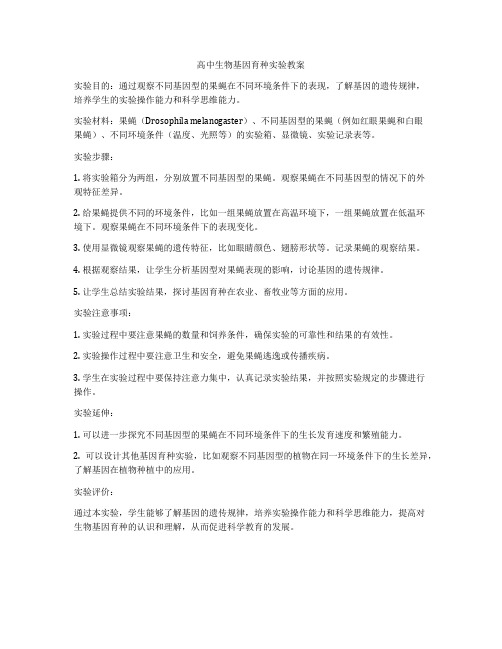
高中生物基因育种实验教案实验目的:通过观察不同基因型的果蝇在不同环境条件下的表现,了解基因的遗传规律,培养学生的实验操作能力和科学思维能力。
实验材料:果蝇(Drosophila melanogaster)、不同基因型的果蝇(例如红眼果蝇和白眼果蝇)、不同环境条件(温度、光照等)的实验箱、显微镜、实验记录表等。
实验步骤:1. 将实验箱分为两组,分别放置不同基因型的果蝇。
观察果蝇在不同基因型的情况下的外观特征差异。
2. 给果蝇提供不同的环境条件,比如一组果蝇放置在高温环境下,一组果蝇放置在低温环境下。
观察果蝇在不同环境条件下的表现变化。
3. 使用显微镜观察果蝇的遗传特征,比如眼睛颜色、翅膀形状等。
记录果蝇的观察结果。
4. 根据观察结果,让学生分析基因型对果蝇表现的影响,讨论基因的遗传规律。
5. 让学生总结实验结果,探讨基因育种在农业、畜牧业等方面的应用。
实验注意事项:1. 实验过程中要注意果蝇的数量和饲养条件,确保实验的可靠性和结果的有效性。
2. 实验操作过程中要注意卫生和安全,避免果蝇逃逸或传播疾病。
3. 学生在实验过程中要保持注意力集中,认真记录实验结果,并按照实验规定的步骤进行操作。
实验延伸:1. 可以进一步探究不同基因型的果蝇在不同环境条件下的生长发育速度和繁殖能力。
2. 可以设计其他基因育种实验,比如观察不同基因型的植物在同一环境条件下的生长差异,了解基因在植物种植中的应用。
实验评价:通过本实验,学生能够了解基因的遗传规律,培养实验操作能力和科学思维能力,提高对生物基因育种的认识和理解,从而促进科学教育的发展。
双荧光素酶报告基因实验步骤

双荧光素酶报告基因实验步骤双荧光素酶报告基因实验是一种常用的生物学实验方法,用于研究基因表达、蛋白质相互作用等生物学过程。
下面将介绍双荧光素酶报告基因实验的详细步骤,希望能对您的实验工作有所帮助。
1. 质粒构建。
首先,需要将双荧光素酶报告基因构建到适当的表达载体中。
一般来说,可以选择pGL3基因表达载体,将双荧光素酶报告基因插入到该载体的多克隆位点中。
构建好的质粒可以用于转染细胞进行后续的实验操作。
2. 细胞培养。
接下来,需要选择适当的细胞系进行实验。
常用的细胞系有HEK293、HeLa等。
将选定的细胞系进行培养,直至细胞密度达到要求,可以进行后续的转染实验。
3. DNA转染。
将构建好的双荧光素酶报告基因质粒转染至培养好的细胞中。
可以选择合适的转染试剂,按照试剂说明书的操作步骤进行转染。
转染后,将细胞培养在含有适当抗性筛选剂的培养基中,以筛选转染成功的细胞。
4. 荧光素酶活性检测。
转染后的细胞需要进行荧光素酶活性检测。
首先将培养基抽取,然后加入荧光素底物,测定细胞中荧光素酶的活性。
可以使用荧光素酶检测试剂盒进行操作,按照说明书进行操作。
5. 双荧光素酶报告基因实验结果分析。
最后,根据实验结果进行数据分析。
可以通过比较不同组的荧光素酶活性来研究基因的表达水平,或者研究蛋白质的相互作用等生物学过程。
通过实验结果,可以得出相应的结论并进行讨论。
以上就是双荧光素酶报告基因实验的详细步骤。
希望对进行该实验的科研工作者有所帮助,也希望大家能够在实验中取得理想的结果。
祝实验顺利!。
基因编辑技术实验报告(3篇)

第1篇一、实验目的基因编辑技术是近年来生物科学领域的一项重大突破,它能够精确地修改生物体的基因组,为生物学研究和应用提供了前所未有的可能性。
本实验旨在了解基因编辑技术的原理和操作流程,掌握CRISPR/Cas9技术的基本操作,并通过实验验证该技术的可靠性和有效性。
二、实验原理基因编辑技术是通过人工核酸酶对基因组进行精确修饰的一种基因工程技术。
CRISPR/Cas9技术是目前最常用的基因编辑技术之一,其原理是利用细菌内源性的CRISPR系统中的Cas9核酸酶,结合一段与目标基因序列互补的sgRNA(single-guide RNA),实现对目标基因的定点敲除、插入或替换。
三、实验材料1. 实验仪器:PCR仪、电泳仪、凝胶成像系统、移液器、培养箱、恒温振荡器等。
2. 实验试剂:CRISPR/Cas9试剂盒、dNTPs、Taq酶、限制性内切酶、连接酶、DNA 标记物、DNA提取试剂盒、质粒提取试剂盒等。
3. 实验菌株:大肠杆菌DH5α、CRISPR/Cas9菌株等。
四、实验方法1. 设计实验方案:根据实验目的,设计CRISPR/Cas9基因编辑实验方案,包括靶基因序列、sgRNA设计、靶位点验证等。
2. 构建CRISPR/Cas9表达载体:根据实验方案,设计sgRNA序列,并将其克隆到CRISPR/Cas9表达载体中。
3. 转化CRISPR/Cas9表达载体:将构建好的CRISPR/Cas9表达载体转化到大肠杆菌DH5α中。
4. 验证CRISPR/Cas9表达载体:通过PCR和测序验证CRISPR/Cas9表达载体的构建。
5. 转化CRISPR/Cas9表达载体到CRISPR/Cas9菌株:将验证好的CRISPR/Cas9表达载体转化到CRISPR/Cas9菌株中。
6. 实验操作:将CRISPR/Cas9菌株接种到含有抗生素的培养基中,培养至对数生长期。
取适量菌株接种到含有靶基因的细胞培养基中,进行基因编辑实验。
《基因工程》实验教学教案

《基因工程》实验教学教案一、实验背景基因工程是一门应用生物学的分支,通过对基因的操作和重组,实现对生物性状的改良和功能的研究。
本实验教学旨在让学生了解基因工程的基本原理,掌握基因克隆、表达和检测的方法,培养学生动手实践能力和创新思维。
二、实验目标1. 了解基因工程的基本原理及实验步骤;2. 掌握PCR扩增、DNA提取、酶切、连接、转化等实验技术;3. 学会分析实验结果,提高学生解决实际问题的能力;4. 培养学生团队合作精神和创新思维。
三、实验内容1. 基因克隆:利用PCR扩增目的基因,并进行酶切、连接,将目的基因插入到载体中;2. 基因转化:将重组载体导入受体细胞,筛选转化成功的细胞;3. 基因表达:对转化成功的细胞进行诱导表达,检测目的蛋白的表达情况;4. 实验结果分析:分析实验数据,探讨实验过程中可能存在的问题,并提出改进措施;四、实验材料与仪器1. 材料:大肠杆菌、质粒、PCR试剂、酶切酶、连接酶等;2. 仪器:PCR仪器、电泳仪、离心机、恒温培养箱、显微镜等。
五、实验步骤1. 实验前的准备工作:了解实验原理,阅读相关文献,准备实验材料和仪器;2. 基因克隆:设计引物,进行PCR扩增,酶切目的基因和载体,连接目的基因与载体,转化大肠杆菌;3. 基因转化:将重组载体导入受体细胞,筛选转化成功的细胞;4. 基因表达:对转化成功的细胞进行诱导表达,检测目的蛋白的表达情况;5. 实验结果分析:分析实验数据,探讨实验过程中可能存在的问题,并提出改进措施;注意事项:1. 严格遵循实验步骤和操作规范,确保实验安全;2. 实验过程中遇到问题,及时与教师沟通,寻求帮助;3. 注重团队合作,共同完成实验任务。
六、实验教学安排1. 理论讲解:2课时2. 实验操作:4课时3. 实验结果分析与讨论:2课时七、实验评价1. 实验操作的正确性和熟练程度;2. 实验结果的准确性及分析的深度;4. 团队合作与沟通能力的展现。
细胞与分子生物学实验

实验操作技巧
掌握正确的实验操作方法 ,如无菌操作、细胞培养 、DNA提取等,保证实验 的准确性和可重复性。
废弃物处理
按照相关规定对实验废弃 物进行分类、处理和处置 ,减少对环境的污染。
常用仪器设备及使用方法
细胞培养箱
提供细胞生长所需的温度、湿 度和气体环境,用于细胞培养 和增殖。
PCR仪
用于扩增特定的DNA片段,是 分子生物学实验中常用的设备 之一。
DNA纯化
去除DNA溶液中的杂质 ,如蛋白质、RNA和多 糖等,常用方法包括乙 醇沉淀、硅胶柱层析等 。
DNA鉴定
通过凝胶电泳、紫外分 光光度计等方法检测 DNA的纯度和浓度,以 及通过PCR、限制性内 切酶酶切等方法鉴定 DNA的序列和结构。
RNA提取、纯化和反转录技术
RNA提取
通过变性剂破碎细胞,释放RNA ,常用方法包括异硫氰酸胍法、
活力检测
通过染色法、荧光法等方法检测细胞 活力,了解细胞的生长状态和存活率 。常用方法有台盼蓝染色法、MTT法 等。
特殊类型细胞培养方法探讨
原代细胞培养
直接从组织或器官中分离出的 细胞进行培养,需模拟体内环 境,提供适当的生长因子和营
养物质。
细胞系培养
经过多次传代后形成的具有稳 定遗传特性的细胞群体,需关 注细胞的遗传稳定性和表型变 化。
干细胞培养
具有自我更新和多向分化潜能 的细胞,需提供特定的生长因 子和微环境以维持其干性。
肿瘤细胞培养
研究肿瘤细胞的生物学特性和 药物筛选,需关注细胞的恶性
表型和异质性。
03
分子生物学基本实验操作
DNA提取、纯化和鉴定方法
DNA提取
通过化学或物理方法破 碎细胞,释放DNA,常 用方法包括酚-氯仿抽提 、SDS裂解法等。
微生物基因操作实验报告

微生物基因操作实验报告
实验目的:通过基因操作技术对微生物进行基因改造,观察其表现
情况,探讨基因操作对微生物的影响。
实验材料与方法:本实验选取大肠杆菌作为实验对象,使用质粒载
体进行基因操作。
首先,将含有目标基因的质粒载体导入大肠杆菌中,通过热激转化等方法将外源基因成功整合到微生物染色体中。
然后,
培养待观察的转基因微生物,在不同条件下进行观察。
实验结果:经过数天培养后,观察到转基因大肠杆菌呈现出与野生
型不同的生长特点。
在特定培养基质下,转基因微生物呈现更快的生
长速度,并在特定条件下表现出抗性等特性。
实验结论:基因操作技术可以成功地改造微生物的基因,使其表现
出不同于野生型的特征。
这为人类利用微生物生产特定蛋白质、抗生
素等提供了新的途径。
同时,基因操作也会带来一定的风险,需要经
过严格的伦理审核和安全管控。
实验意义:微生物基因操作实验的成功进行,拓展了生物技术领域
的研究与应用。
通过基因操作,人类可以更深入地了解微生物的机制
与特性,为生物科学的发展带来新的可能性。
总结:微生物基因操作实验是一项具有挑战性和潜力的研究领域,
在遵守伦理原则和安全规范的前提下,不断深入探索微生物的基因调
控机制,为人类社会的进步与发展做出贡献。
大学生物学实验:细胞分裂与遗传基因
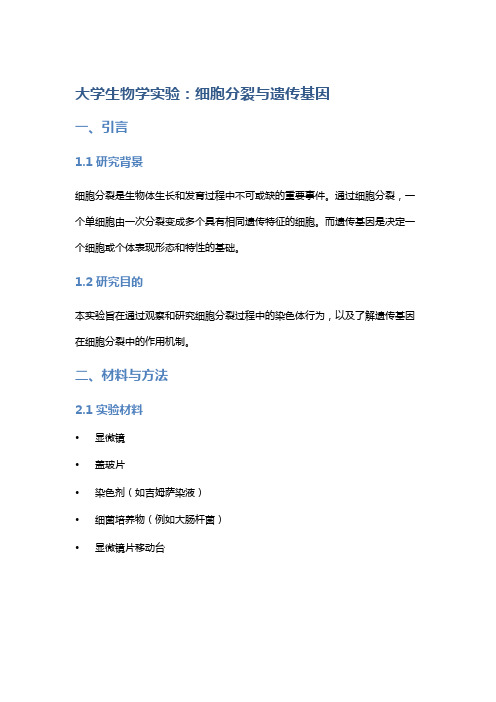
大学生物学实验:细胞分裂与遗传基因一、引言1.1 研究背景细胞分裂是生物体生长和发育过程中不可或缺的重要事件。
通过细胞分裂,一个单细胞由一次分裂变成多个具有相同遗传特征的细胞。
而遗传基因是决定一个细胞或个体表现形态和特性的基础。
1.2 研究目的本实验旨在通过观察和研究细胞分裂过程中的染色体行为,以及了解遗传基因在细胞分裂中的作用机制。
二、材料与方法2.1 实验材料•显微镜•盖玻片•染色剂(如吉姆萨染液)•细菌培养物(例如大肠杆菌)•显微镜片移动台2.2 实验步骤步骤1:细菌培养与样本制备•在无菌培养条件下,将所需数量的大肠杆菌接种到含有适当营养物的琼脂平板上。
•在37摄氏度恒温箱中孵育过夜,以便细菌生长。
步骤2:制备显微镜样品•使用无菌的移液器将一小滴吉姆萨染液滴在盖玻片上。
•使用无菌的取样环将一小圈细菌培养物从琼脂平板上取出,转移到已涂有吉姆萨染液的盖玻片上。
•轻轻晃动盖玻片,使细菌均匀分布在整个区域上。
步骤3:观察细胞分裂与遗传基因•将制备好的显微镜样本放置在显微镜上,并调节合适的放大倍数。
•观察并记录下细菌分裂和染色体行为情况,注意任何异常变化。
三、实验结果与讨论3.1 细菌分裂过程观察通过显微镜观察,在正常条件下,我们可以看到细菌表现出二分裂数增殖方式。
起初,一个单细胞会逐渐变成两个等大小的子细胞。
这是由于原核生物中DNA 的复制和细胞质的分离导致的。
3.2 染色体行为观察染色体是细胞中的遗传物质,通过染色剂染色后可以更清晰地观察到其行为。
在细菌分裂过程中,我们可以观察到染色体会从一个单一的结构(原始核)分离为两个结构,并向两个子细胞运输。
3.3 遗传基因研究通过研究细菌分裂和染色体行为,我们可以深入了解遗传基因在细胞遗传过程中的作用。
遗传基因是决定一个细胞或个体表现形态和特性的基础。
通过进一步研究各种突变体和不同类型的遗传变异,我们能够揭示出有关遗传代谢、发育和适应性等方面的关键信息。
细胞生物学实验指导

实验一动物细胞的传代培养一、实验目的1.熟悉细胞培养过程中的无菌操作技术。
2.了解细胞传代培养的基本方法和主要操作步骤二、实验原理细胞培养(cell culture)是指从机体内取出某种组织或细胞,模拟机体内的生理条件使其在体外生存、生长和繁殖的过程。
细胞的体外培养在细胞生物学和医学研究领域有着极为广泛的用途,这一技术已成为研究细胞生理、细胞增殖、细胞遗传、细胞癌变和细胞工程等课题的一项不可缺少的手段。
细胞培养技术的突出优点在于能为研究者提供大量的生物性状相同的细胞作为研究对象,便于人们在体外利用各种不同的方法从不同的角度研究细胞生命活动的规律。
另外,利用细胞培养技术还可使人们较为方便地研究各种物理、化学和生物因素对细胞结构和功能的影响。
细胞培养可分为原代培养和传代培养2种情况。
所谓原代培养(primary culture)是指直接从机体取出组织或细胞后所进行的首次培养。
而传代培养(subculture)是指当原代培养的细胞增殖到一定密度后,将其从原培养容器中取出,以1:2或其他比例转移到另一个或几个容器中所进行的再培养。
传代培养可简称传代。
在体外培养过程中,要使细胞能正常地生长、繁殖,需经常对其进行传代。
传代的累积次数就是细胞的代数。
在从事细胞培养工作时常常会接触到细胞系(cell line)和细胞株(cell strain)这两个容易混淆的概念。
一般认为,细胞系指通过原代培养并经传代后所形成的细胞群体,由于细胞系来源于原代培养,而原代培养物中所含的细胞种类较多,故一个细胞系往往由多个生物学性状不同的细胞群体所组成,而细胞株是利用单细胞分离培养法或克隆形成法从原代培养物或细胞系中选择出的细胞群体,一个细胞株往往具有特殊的生物学性状或标记并可持续存在。
细胞培养是一种程序复杂、条件较多且要求严格的实验性工作。
由于细胞在体外的生长、繁殖会受到温度、营养物质、酸碱度、渗透压及微生物等多种因素的显着影响,故细胞培养工作的各个环节如培养器皿清洗消毒、营养液配制和除菌、pH值调整、温度调节等操作都有严格的要求和规定,特别要注意无菌操作,这是细胞体外培养成败的关键。
基因工程主要操作流程及图解

基因功能研究
通过动物模型研究基因在生物体内的功能及 其调控机制,揭示生命活动的本质。
动物模型构建方法和注意事项
构建方法:包括自然 突变筛选、化学诱变、 物理诱变和基因编辑 技术等。其中,基因 编辑技术如CRISPRCas9等已成为主流方 法。
注意事项
选择合适的动物种类 和品系,确保实验结 果的准确性和可重复 性。
基因工程主要操作流程及图解
$number {01}
目 录
• 基因工程概述 • 基因工程基本操作流程 • 基因表达调控技术 • 蛋白质纯化与功能分析技术 • 细胞培养、转染和稳定株构建技
术 • 动物模型在基因工程中应用 • 总结与展望
01
基因工程概述
定义与发展历程
定义
基因工程是通过改变生物体的遗传物 质,来实现对生物性状和功能的定向 改造的一门技术。
通过基因编辑技术(如CRISPR-Cas9)或基因重组技术将目的基因整合到细胞基因组中,实现稳定表达。
筛选方法
利用抗生素抗性基因或荧光标记基因进行初步筛选,再通过qPCR、Western blot等方法对稳定株进 行鉴定和验证。
06
动物模型在基因工程中应用
常见动物模型类型及其特点
小鼠模型
繁殖周期短,基因型确定,适合大规模遗传研 究。
转化细胞筛选与鉴定
01
02
03
抗性筛选
报告基因检测
PCR或测序鉴定
利用选择性培养基筛选转化细胞, 如抗生素或营养缺陷型培养基。
通过检测报告基因的表达情况, 间接判断目标基因是否整合到受 体细胞基因组中。
利用PCR或测序技术直接检测目 标基因在转化细胞中的存在和表 达情况。
03
基因表达调控技术
生物学案:基因工程的基本操作程序

1.2 基因工程的基本操作程序1.简述基因工程的原理及基本操作程序。
2.尝试设计某一转基因生物的研制过程。
一、目的基因的获取1.从基因文库中获取目的基因将含有某种生物不同______的DNA片段导入________的群体中储存,各个________分别含有这种生物的不同的基因,称为基因文库。
基因文库包括两种:________文库,即包含一种生物所有基因的文库;________文库,即只包含一种生物的一部分基因的文库,如______文库。
2.利用PCR(1)PCR的含义:是一项在生物______复制特定DNA片段的核酸合成技术。
(2)目的:短时间内大量扩增目的基因。
(3)原理:__________。
(4)过程:第一步,加热至90~95 ℃,________________。
第二步,冷却至55~60 ℃,________________________________________________。
第三步,加热至70~75 ℃,________________________________________________。
如此重复循环多次.(5)特点:指数形式扩增。
3.用化学方法人工合成如果基因比较____,核苷酸序列又已知,也可以通过DNA合成仪用化学方法直接人工合成。
二、基因表达载体的构建基因表达载体的组成:必须有启动子、________、终止子以及________等。
1.启动子启动子是一段有特殊结构的______片段,位于基因的首端,是____________________的部位,可驱动基因______。
2.终止子终止子也是一段______短片段,位于基因尾端,使______在需要的地方停止。
3.标记基因标记基因的作用是为了鉴定受体细胞中是否含有________,从而将含有________的细胞筛选出来。
三、将目的基因导入受体细胞1.转化________进入受体细胞内,并且在受体细胞内________和______的过程,称为转化。
- 1、下载文档前请自行甄别文档内容的完整性,平台不提供额外的编辑、内容补充、找答案等附加服务。
- 2、"仅部分预览"的文档,不可在线预览部分如存在完整性等问题,可反馈申请退款(可完整预览的文档不适用该条件!)。
- 3、如文档侵犯您的权益,请联系客服反馈,我们会尽快为您处理(人工客服工作时间:9:00-18:30)。
Gene correction with CRISPR/Cas9
Chapter 2: Genome editing tools
Generation of genome editing tools
◆ Meganuclease ◆ Zinc-finger nuclease (ZFN) ◆ Transcription activator- like effector nuclease (TALEN) ◆ RNA- guided endonuclease (CRISPR-Cas)
Cas3
Mature crRNA Mature crRNA
PAM RuvC
With off-target cleavage Minimal off-target cleavage No immunogenicity May have immunogenicity
DeFrancesco L. Nature Biotechnology 2011, 29(8): 681-684
Cellular genome editing
Jia Chen School of Life Science and Technology, Shanghaiiting is getting hotter and hotter
What can we do with genome editing?
Cascade pre-crRNA
c
Type II
Cas9 RNase III pre-crRNA
d
Type III
Cas6 pre-crRNA
tracrRNA
Cmr/Cas10 Csm/Cas10 crRNA biogenesis
Intermediate crRNA Intermediate crRNA Mature crRNA
geted DNA double-stran genome editing through Subsequently, Carroll a potential of designer nu for efficient, locus-spec Moreover, it was shown ogy repair template that deletion mutations (inde end-joining (NHEJ) repa 2002). These early geno induced HR and NHEJ and precise modification To achieve effective g specific DNA DSBs, fou binding proteins have b derived from microbial 2006), zinc finger (ZF) nu tion factors (Urnov et al. activator-like effectors (Christian et al., 2010; M cou and Bogdanove, 20 DNA endonuclease Cas9 mune system CRISPR (C Meganuclease, ZF, an DNA sequences throug meganucleases integra
TALEN Vs. ZFN
DeFrancesco L. Nature Biotechnology 2011, 29(8): 681-684
Transcription activator- like effector nuclease (TALEN)
Pros ◆ Highly programmable Cons ◆ Hard to make and keep plasmids ◆ High efficiency ◆ Not suitable for high throughput ◆ Minimal off-targeting cleavage screening
Conventional knockout method
Conventional knockout method
Cons ◆ Low efficiency (10-6) ◆ Cell type limitation ◆ Labor consuming ◆ Money consuming ◆ Disappointing ☹ Pros ◆ High precision
Zinc-finger nuclease (ZFN)
Adapted from Urnov et al. 2010
◆ Artificial restriction enzymes generated by fusing a zinc finger DNA-binding domain to a DNA-cleavage domain
Transcription activator- like effector nuclease (TALEN)
Miller et al. Nature Biotechnology, 2011, 29: 143-148.
TALEN Vs. ZFN
ZFNs Recognize a nucleotide triplet Target specific sequence Context dependence TALENs Recognize single nucleotides Target any sequence Context independence
Clustered regulatory interspaced short palindromic repeat (CRISPR)/ CRISPR associated protein (Cas)-based RNA-guided DNA endonucleases (CRISPR-Cas)
Discovery of CRISPR/Cas system
Keith Joung, OPEN (Oligomerized Pool Engineering)
Zinc-finger nuclease (ZFN)
Pros ◆ Programmable Cons ◆ Hard to find ZFA
◆ High efficiency
◆ Off-targeting cleavage
Zinc Finger Array (ZFA)
Adapted from Urnov et al. 2010
◆ However, finding efficient Zinc Finger Array (ZFA) is hard!
Patented Vs. Open recourse
Sangamo BioSciences
d
Type III
Cas6 pre-crRNA
Annu Rev Microbiol. 2015 Jul 22. [Epub ahead of print]
Repeat Spacer
Mechanism of CRISPR/Cas system
Leader/promoter cas cas
b
Type I
Meganuclease
María José Marcaida et al. PNAS 2008;105:16888-16893
Meganuclease
Pros ◆ Very high specificity Cons ◆ Recognize limited target sites ◆ Hard to modify the enzyme ◆ Have never been widely used
Bhaya D, et al. Annu. Rev. Genet. 2011. 45:273–97
H11-Marraffini
CRISPR Provides Acquired Resistance Against Viruses in Prokaryotes
ARI 14 July 2015 9:37
Knockout with DNA endonuclease
(Double Strand Break)
(Non-Homologous End Joining)
Indel (Insertion or deletion)
Knockout with DNA endonuclease
Pros ◆ High efficiency (50%) ◆ No cell type limitation ◆ Labor saving ◆ Money saving ◆ Encouraging ☺ Cons ◆ Off-targeting
Why knock in a gene?
Conventional knockin method
Conventional knockin method
Cons ◆ Low efficiency (10-6) ◆ Cell type limitation ◆ Labor consuming ◆ Money consuming Pros ◆ High precision
◆ ◆ ◆
1987: DNA repeat arrays in the intergenic region adjacent to the alkaline phosphatase (iap) gene in Escherichia coli K12. 2002: coining of the CRISPR acronym. 2005: the hypervariable spacers showed sequence homology to viruses or plasmids and hypothesized that CRISPRs and associated proteins could play a role in immunity against transmissible genetic elements.
